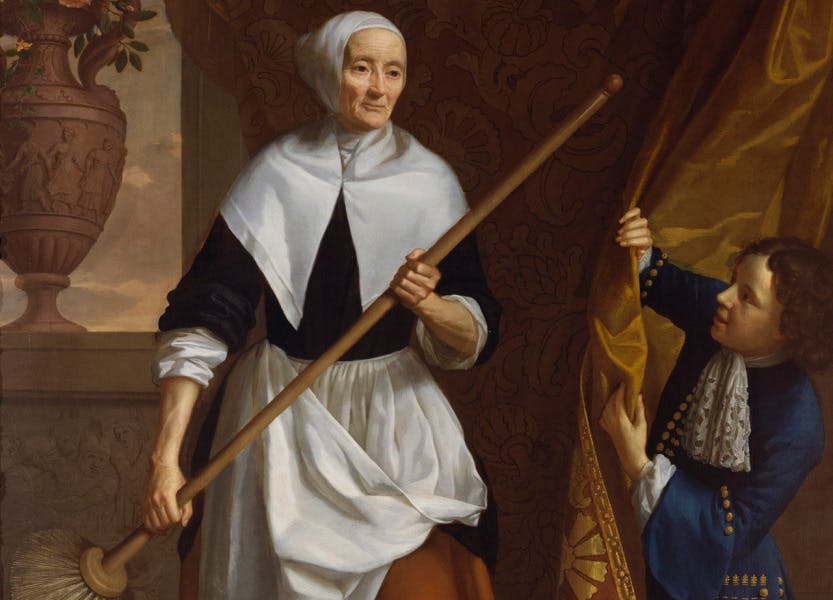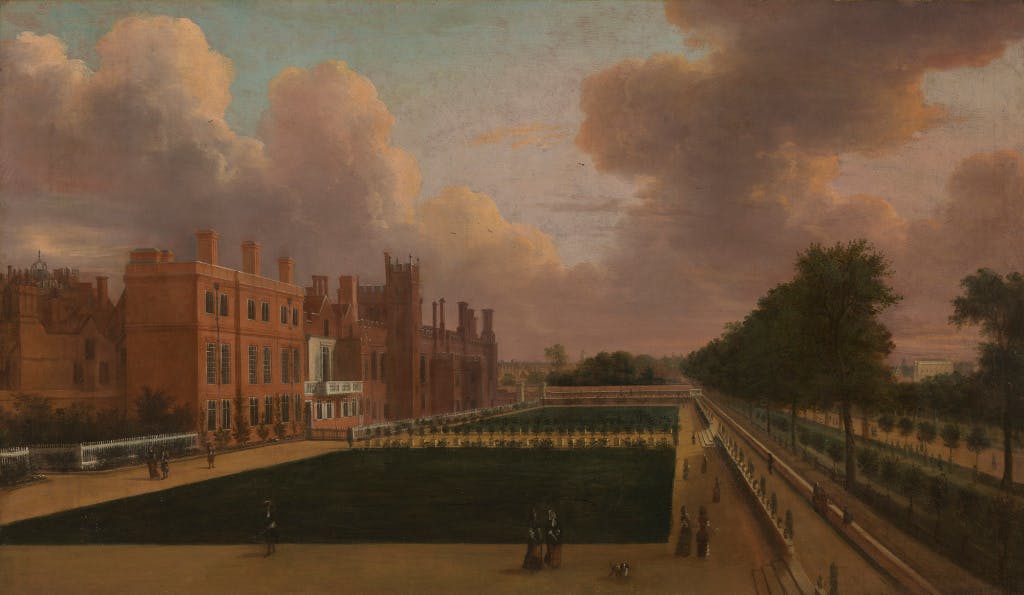'Below Stairs' in Sickness, Death and Old Age: Petitioning the Board of Green Cloth
Date: 29 February 2024
Author:
Misha Ewen
What happened to those who worked in the royal palaces when they fell ill, grew old, or when they died, leaving loved ones behind? The records of the Board of Green Cloth shed light on the outcomes for the ordinary women, children, and men who turned to the palace in times of crisis during the 17th and 18th centuries.
In April 1686, Richard Hodges, who had previously been employed as a linen carrier in the royal household, petitioned the Board of Green Cloth and asked for their help. Richard had worked at St James’s Palace, in the household of the then Duke of York — crowned James VII and II in 1685. Richard’s role was to transport linen from James’s private apartments to the laundry – an important duty for a trustworthy and discreet employee.
But when Richard came before the board, his working days were done. In ‘consideration of his great Age… and of his former services’, the board granted him a pension of five shillings per week to live on for the rest of his life.
As well as a pension for Richard, the board agreed to pay five shillings per week to a woman named Mary Watson, as recompense for her care of Richard. It’s not clear what their relationship was, or whether she was already providing care to Richard, but it tells us that the board was not simply providing retired employees with a living allowance. Rather, the board intended that people like Richard would have ongoing care and security in their old age. Mary would provide care to Richard in the final years of his life – food, lodging, and possibly even personal care, such as washing, dressing, and feeding.
What was the Board of Green Cloth?
The Board of Green Cloth originated in the medieval period. Headed up by the Lord Steward, it was responsible for the management of several royal household departments ‘below stairs’, including the kitchens, laundry, and woodyard.
The board’s responsibilities included overseeing household expenditure and maintaining law and order, including hearing the petitions and complaints of current and former employees. This involved hearing about everything from violent confrontations and stolen silverware, to rude words spoken between colleagues at work. But, as Richard’s example suggests, the board also took on some social responsibility for those under its jurisdiction.
Records of the board’s decisions survive in The National Archives, from which we can learn a great deal about the ordinary women, children, and men who inhabited the royal household in the 17th and 18th centuries.
Support in Times of Crisis
People turned to the Board of Green Cloth during periods of illness, in the event of a death, and in financial hardship. The current cost of living crisis in the UK – which is forcing people to choose between feeding their children and heating their homes – was a reality for many in this period. We might not expect to learn about their experiences, and the financial insecurity they faced, from the royal household records, but they bring into focus the pressures and hardships faced by ordinary people.
Employment within, or a connection to, the royal court did not insulate individuals from poverty, but it does seem that the board tried to alleviate their suffering. In October 1687, as the winter nights drew in, Thomas Smith, who was formerly an assistant in the kitchens, was granted twelve pence per day ‘to enable him to support himself in his present extremity and indisposition’.
Then, in 1717, the orphaned children of William Tomlin, who was employed as a scourer in the kitchen (which was not well-paid position), were granted £10 per year for life, ‘they being all poor and blind’. The board recognised that without William’s income, and as they were unable to work themselves, his children faced extreme poverty.
Tools of Persuasion
People tried different ways to secure the help of the board. Some presented themselves as desperate and in need, while others highlighted that they were loyal servants with a long history of dedicated service.
One of the most interesting examples comes from the petition of Elizabeth and Margaret Maculls, a mother and daughter, who petitioned the board in 1702 for financial aid. To garner the board’s support and demonstrate that they were entitled to – and worthy of – its charity, they drew upon ideas of kinship and ancestry, service and legacy. They described how ‘Margaret Chaplin (your petitioners’ grandmother)… and her mother had successively been sempstresses to the household, ever since the reign of Queen Elizabeth’ (referring to Queen Elizabeth I, who died in 1603).
According to Elizabeth and Margaret, (and I do think I believe them) successive women in the same family had served in the role of ‘sempstress’ or seamstress – inherited from mother to daughter – for at least 100 years. Like the Stuarts, they were themselves a longstanding dynasty.
If that wasn’t enough, Elizabeth and Margaret signalled their devotion and loyalty to the crown by describing their connection to the household in relation to a key event in monarchical history: the ‘happy Restoration’. The Restoration of 1660 was the term used to describe the crowning of Charles II eleven years after his father, Charles I, was executed. Elizabeth and Margaret made sure that the board was in no doubt about where their family’s loyalties lay.
The Fate of the 'Deserving' (and 'Undeserving') Poor
The board was not the only institution that provided financial assistance to people out of obligation, or perhaps even genuine care. Many people turned to the local aristocracy, their parish church, or their town council in their hour of need. Depending on their circumstances – essentially whether those in positions of power and privilege deemed them to be good citizens who were worthy of charity – help was forthcoming.
It’s impossible to sugar coat this period of history. Many people were neglected, including the so-called ‘undeserving poor’, and they lived and died in destitution when it could have been avoided.
How exactly the Board of Green Cloth functioned in relation to this wider system and the other safeguards which were in place across 17th- and 18th-century England needs further investigation, but these records pose interesting questions. Did palace employees go to the board or their parish first? Which was viewed as a last resort? And did the board follow wider societal norms when it came to deciding who deserved their help? Rightly or wrongly, the examples of the aged Richard, poverty-stricken Thomas, Elizabeth, and Margaret, and the orphaned Tomlins children, suggests that they did.
The extravagant wealth of the royal court operated in stark contrast to the circumstances faced by the many who knew the palaces well: the women, children, and men, and their families, who worked within them, doing jobs like repairing clothes, preparing food, or carrying linen. Ordinary life events – illness, aging, or losing a spouse – threatened to sink you into extreme poverty. A lucky few were spared.
Dr Misha Ewen
Historian and Lecturer at the University of Bristol

Untold Lives
Until 27 October 2024
A new exhibition at Kensington Palace, uncovering the forgotten stories of those who worked at the royal palaces over 300 years ago.
More from our blog

Royal Wetnurses: the 'Foster Mothers' of the Georgian Nursery
24 March 2022
Ahead of Mother's Day, we share the lesser-known histories of the women employed as wetnurses in the Royal Nursery. Taking on the role of 'foster mother' to young princes and princesses, they often developed a close personal bond with the royal family and received mementos that were passed down in families for generations.

Charles II's Coronation Procession from the Tower of London
24 April 2023
Curator of Historic Buildings, Alden Gregory, takes a look at Charles II's Coronation - the last coronation in which the Tower of London played a starring role.

The Wedding of Captain Scott and Kathleen Bruce at Hampton Court Palace
04 January 2024
Assistant Curator Minette Butler explores how Captain Scott's wedding to his beloved wife Kathleen Bruce at Hampton Court Palace intertwines with the aftermath of his ill-fated expedition to reach the South Pole.

